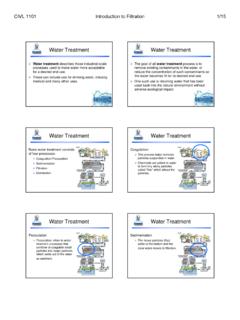Transcription of Introduction to Water - Deep Run Farm Hunting …
1 25 June 2009 The Sportsman s Magazine Introduction to WaterBy Jack JagodaA retriever s high-fly-ing entry followed by a spectacular explosion of Water will take your breath away. Although retrievers have webbed feet and are classified as Water dogs, some take to Water naturally and others require care-ful Sportsman s Magazine June 2009 An enthusiastic puppy may leap into Water over his head, get dunked and be troubled around Water forever. Others take to it like a fish and have no problem whatsoever. Then there are some that simply have no use for Water unless it s in a bowl. I am always amazed at new puppy owners who come to pick up puppies in February and ask if their pup has been in the Water yet. After last February here in Virginia, the answer might be on the Water , but surely not in it. It is important to have the right Water and air temperature to start your puppy in the Water . Unless you feel comfortable enough to wade in barefooted, it is probably too cold for a puppy to be introduced to Water .
2 Look for Water with a gradual drop-off in depth, maybe a boat ramp or sand bar. Put on some shorts or boots and back into the Water a couple of feet, clap your hands and call your puppy. If he follows you, great! If that doesn t work, walk up on shore, pick him up and place him in shallow Water with your hands under him and let him swim to shore. Repeat this several times, then see if he will follow you in. Puppies chill easily, and even if the Water is warm, you should have a towel handy to dry the puppy off after his first Water adventure. A high-spirited puppy usually has no problem, but use caution to prevent your puppy from going underwater. This often makes a difference as to whether your dog enters Water with enthusiasm or tiptoes in. Once he is swimming, it s time to throw something in the Water to retrieve. I back up from the Water and throw a bumper in at the Water s edge. If that goes well, try a toss into swimming Water ; only a few feet at first, then slowly increase the distance.
3 You may notice as you increase the distance of the throw that the dog will have a difficult time remaining level while swimming. Puppies often lift up out of the Water to look for the bumper, quit swimming, go under, become scared and paddle frantically. That s why you shouldn t throw the bumper very far at first in case you have to go in and help him. You will also notice that once the dog gets the bumper in his mouth, he will have no problem swimming and level off on the return. When your puppy is 12 to 14 weeks old and comfortable in the Water , it s time to introduce a boat. We start with a boat on dry ground, letting the puppy climb in and out and make a few retrieves, pulling him in over the side as he returns with the bumper. When he is comfortable with the boat, it s time to get in the boat and paddle out in shallow Water . Call the puppy to you and help him in over the side, then pick him up and lower him back in the Water .
4 Soon he 27 June 2009 The Sportsman s Magazine will be jumping in and out like an old salt. Once your dog is confident and swimming correctly, you can extend the distance of the retrieve. Don t get carried away; keep the throws a moderate distance. Use a bright, visible bumper that sits high in the Water . Get as close to the Water s edge as possible and throw the bumper straight out in the Water at a 90-degree angle to the shore. Throws that are angled down a shoreline only encourage your dog to run along the shore and avoid the Water . Pups learn plenty of bad habits on their own; don t promote them. If your puppy wants to swim around and play keep-away with the bumper, use a floating rope as a check cord to bring the puppy back to you. Puppies must understand that the same rules apply in the Water as on land. Any time your dog ignores any basic obedience skill, stop retrieving, go back to the yard and correct the basic behavior.
5 Try to avoid disciplining your dog in conjunction with retrieving, especially in the Water . This will only confuse him and make him feel that retrieving is bad. Puppies will often retrieve decoys, so don t get upset if this happens. Just pat him on the head for making such a great retrieve. Continue with his retrieving, bringing the bumper closer and closer to the decoys, and this will eventually go away. Your puppy should be taught to ignore decoys on land before you introduce them in Water . He should also be retrieving bumpers and birds in, around and through decoys. He will soon learn that a floating decoy is even harder to move than one on land, and will go for the bumper. Dogs do have a sense of humor and I think they often do things to see if they can get a reaction out of us. If you make a big fuss about retrieving decoys, you may inadvertently encourage that behavior. Go slow. Be patient.
6 This is supposed to be fun! Next month I am going to cover the SRS, Super Retriever Series Crown Championship in Little Rock, Arkansas. I have the privilege of judging this prestigious event and visiting with some of my old friends while enjoying the finest retriever and handler teams in the world. Deep Run Farm is a retriever training, breeding and boarding facility in Goldvein, Va. Jack and his partner Phyllis Giroux, DVM, are living their lifetime dream. Visit them on the Web at and feel free to e-mail Jack at with questions.









